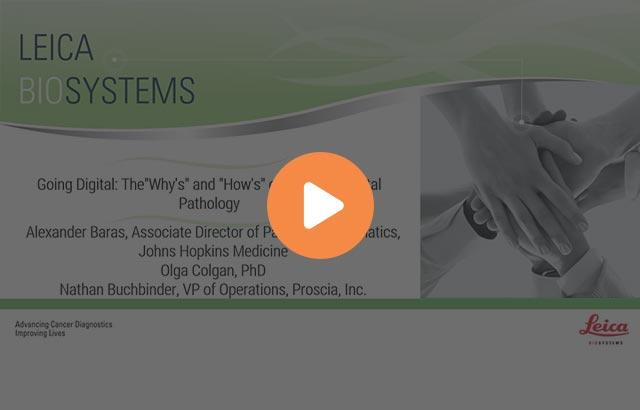
Realized Benefits of Digital Pathology in a Clinical Setting




Table of Contents
- Rethinking ROI in Digital Pathology
- How AI Empowers Pathologists
- Advice for Implementing Digital Pathology
- Conclusion
The promise of digital pathology is undeniable. From enabling remote access and streamlining workflows to reducing storage needs and fostering collaboration, the benefits are clear. Yet despite these advantages, healthcare institutions may hesitate to invest without a clearly demonstrated return on investment (ROI). As digital pathology reshapes how diagnostic services are delivered and scaled, it raises a pivotal question: Should ROI be the only lens through which we evaluate healthcare innovations like digital pathology, or is it time to adopt a broader framework?
At the Executive War College in New Orleans, Louisiana, Mark Frushone, Global Director of Digital Pathology at Leica Biosystems, led a panel of industry leaders to explore how we can better define and measure the value of implementing digital pathology. Joining him were Orly Ardon, PhD, MBA, Director of Digital Pathology Operations at Memorial Sloan Kettering Cancer Center; Cory A. Roberts, MD, MBA, CEO of Sonic Healthcare USA; and Derek C. Welch, MD, President and Chief Medical Officer at PathGroup. Their insights offered valuable perspectives from both clinical and operational standpoints across leading healthcare institutions.
Rethinking ROI in Digital Pathology
Digital pathology isn’t just another capital investment; it’s a transformative shift. As Dr. Ardon emphasized, viewing it through the narrow lens of a five- or seven-year ROI fails to capture its full impact. This technology reshapes not only pathology departments but the entire healthcare delivery model. Institutions should consider a more strategic, long-term perspective—one that includes improved clinical outcomes, operational efficiencies, and strategic readiness for future innovations. Dr. Ardon made the point clear, “If you don't start investing now, you will not be able to really reap all those benefits that are coming.”
Dr. Roberts and Dr. Welch highlighted measurable benefits such as reduced staff turnover, enhanced recruitment, and cost savings from centralized workflows and reduced travel. “We built ROI by digitizing IHC slides and providing digital access within hours instead of overnight shipping. That alone created significant savings,” explained Dr. Roberts. “But beyond that, retention and recruitment of pathologists; those are very real, measurable benefits.”
Equally significant, digital pathology improves patient care by enabling faster access to subspecialist expertise, regardless of geographic location. This means more accurate diagnoses, quicker turnaround times, and better-informed treatment decisions, which are especially critical in complex or rare cases where timely expert input can make a significant difference.
Dr. Welch also noted that the flexibility of digital pathology to enable remote work has opened new business opportunities in underserved regions, offering an unexpected but significant advantage. Notably, this flexibility is even prompting some pathologists to reconsider retirement, helping to address the long-standing national shortage of pathology professionals.
How AI Empowers Pathologists
The panelists unanimously agreed that one of the most compelling reasons to invest in digital pathology is its role as a foundation for artificial intelligence (AI). Without a digital infrastructure, healthcare systems cannot harness the rapidly evolving AI tools that are reshaping diagnostics.
When it comes to the goal of AI, it’s not about replacing pathologists, but empowering them. “We have given [pathologists] a tool that's better,” noted Dr. Welch. “We've given them given them a chainsaw instead of an axe.”
AI can assist in screening, triage, pattern recognition, and mutation detection, which all enhance diagnostic consistency and accuracy. Dr. Ardon shared that every pathologist who tested AI tools at her institution recognized the inherent value of AI, with none expressing concern about being replaced by it. Dr. Roberts pointed out that AI is already well integrated in radiology, and similar adoption in pathology is inevitable, especially as costs decrease and tools become more accessible.
Dr. Welch also emphasized the democratizing effect: AI can expand access to high-quality diagnostics. He challenged the audience to consider whether they would want an AI tool to assist in their own cancer diagnosis. The answer, he suggested, is almost always yes. “In the overall picture of cancer care, specifically, why would you not use a tool that enhances the outcome and viability of the diagnosis?” Dr. Welch asserted.
Lessons from the Field: Advice for Implementing Digital Pathology
Understandably, transitioning to digital pathology is a significant undertaking that requires thoughtful planning and strong leadership. It’s not a one-time upgrade; it’s a department-wide transformation that requires ongoing support and adaptability.
Dr. Welch shared how his team transitioned 40 pathologists to digital overnight, with a surprisingly short learning curve and high adoption rate. His advice: be bold and embrace the change. Dr. Roberts added that implementation should be driven by specific institutional needs and challenges, and not a desire to keep up with industry trends. Afterall, digital pathology is a tool, not a goal. It should serve a clear purpose within a broader strategy.
Conclusion
Ultimately, successful adoption of digital pathology depends on aligning technology with institutional priorities, engaging stakeholders early, and maintaining a long-term vision. While the transition may seem daunting, the collective experience of early adopters shows that with the right leadership, planning, and flexibility, the benefits can be both operational and clinical, and ultimately transformative.
To dive deeper into the insights shared by these industry leaders, we invite you to listen to the full roundtable session from the Executive War College.
About the presenters

Mark Frushone Global Director Commercial Development Leica Biosystems based in Vista, California. For over 25 years, Mark has been a leader in the Health Care industry. Mark joined Leica Biosystems in 2012 as a Market Manager in Emerging Markets, focused on digital pathology enablement across the world. Before this Mark was a Sr. Application Specialist In-Direct Channel at Aperio Inc. Mark has been in the laboratory and digital pathology space for over 14 years. Mark has a Master's in Education from National University and a Bachelor of Science from Central Connecticut.

Dr. Cory Roberts is CEO of Sonic Healthcare USA and a board-certified anatomic and clinical pathologist. He has been active teaching generations of future pathologists, running premier pathology practices and laboratories, and leading cutting-edge research projects. Dr. Roberts has published four books and numerous peer-reviewed works, book chapters, and abstracts as well as lectured widely in gastrointestinal and hepatobiliary pathology and the business of healthcare.

Director of Digital Pathology Operations, member of the Warren Alpert Center for Digital and Computational Pathology, and an associate member at the Department of Pathology and Laboratory Medicine at Memorial Sloan Kettering Cancer Center. She is also a board member of the DPA. Her work in digital pathology is centered on innovation and operational aspects of digital technologies as well as the clinical implementation of laboratory automation.

President and Chief Medical Officer of PathGroup and a board-certified pathologist who earned his medical degree from Vanderbilt University and completed his Clinical and Anatomic Pathology residency, serving as Chief Resident and Instructor. He has published articles in peer-reviewed journals and has been a platform presenter at the U.S./Canadian Academy of Pathologists annual meeting. He is a Fellow of the CAP and Roger C. Haggitt Gastrointestinal Pathology Society.
Related Content
Leica Biosystems Knowledge Pathway content is subject to the Leica Biosystems website terms of use, available at: Legal Notice. The content, including webinars, training presentations and related materials is intended to provide general information regarding particular subjects of interest to health care professionals and is not intended to be, and should not be construed as, medical, regulatory or legal advice. The views and opinions expressed in any third-party content reflect the personal views and opinions of the speaker(s)/author(s) and do not necessarily represent or reflect the views or opinions of Leica Biosystems, its employees or agents. Any links contained in the content which provides access to third party resources or content is provided for convenience only.
For the use of any product, the applicable product documentation, including information guides, inserts and operation manuals should be consulted.
Copyright © 2026 Leica Biosystems division of Leica Microsystems, Inc. and its Leica Biosystems affiliates. All rights reserved. LEICA and the Leica Logo are registered trademarks of Leica Microsystems IR GmbH.


